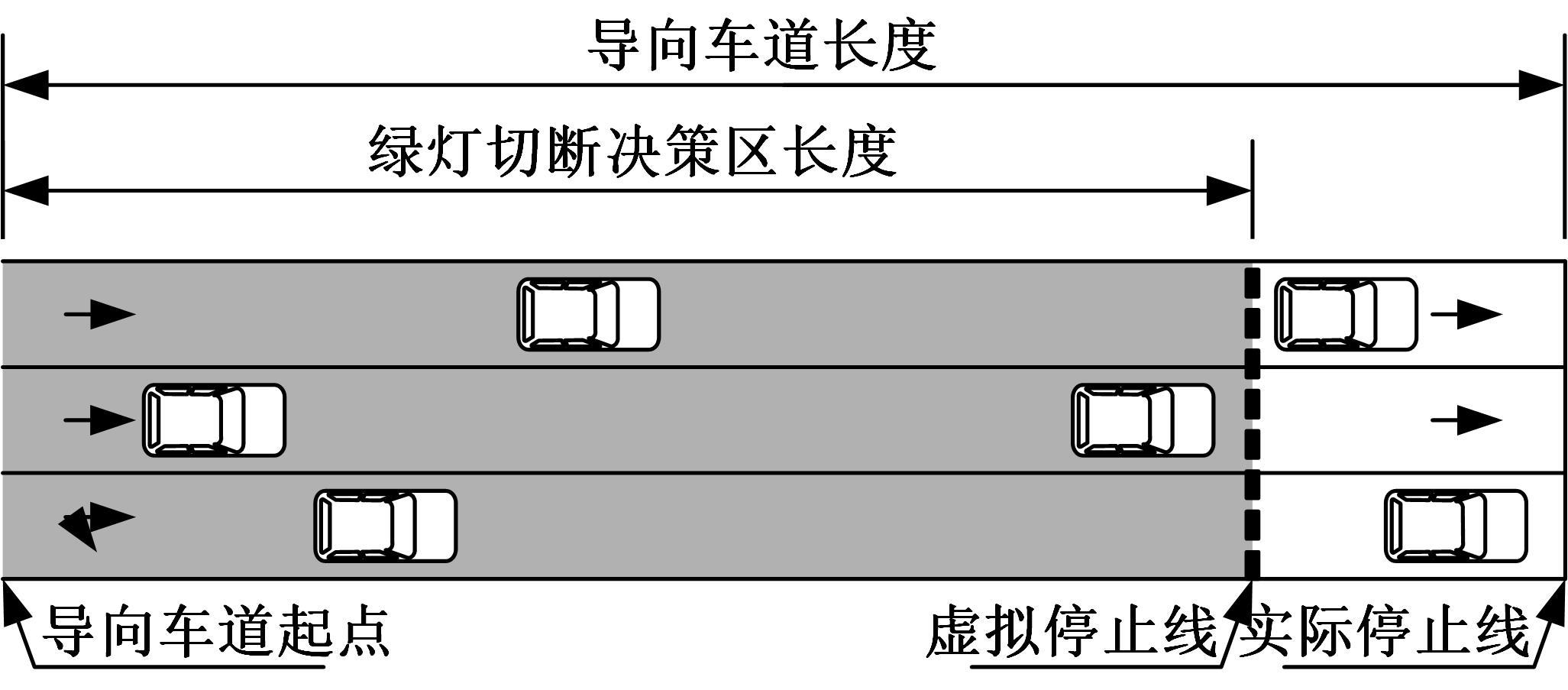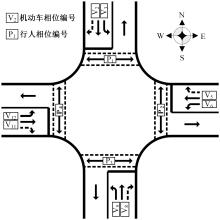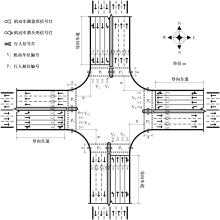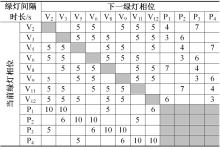吉林大学学报(工学版) ›› 2022, Vol. 52 ›› Issue (6): 1324-1336.doi: 10.13229/j.cnki.jdxbgxb20210067
• 交通运输工程·土木工程 • 上一篇
面向网联汽车环境的单点全感应式信号配时技术
- 1.大连理工大学 交通运输学院,辽宁 大连 116024
2.沈阳市规划设计研究院有限公司,沈阳 110004
3.青岛市城市规划设计研究院,山东 青岛 266000
Fully⁃actuated signal timing technique for isolated signalized intersections in connected vehicle environment
Hong-feng XU1( ),Hong-jin CHEN1,Dong ZHANG1,Qian-hui LU1,Na AN2,Xian-cai Geng3
),Hong-jin CHEN1,Dong ZHANG1,Qian-hui LU1,Na AN2,Xian-cai Geng3
- 1.School of Transportation and Logistics,Dalian University of Technology,Dalian 116024,China
2.Shenyang Urban Planning and Design Institute Co. ,Ltd. ,Shenyang 110004,China
3.Qingdao Urban Planning & Design Research Institute,Qingdao 266000,China
摘要:
面向网联汽车渗透率达到100%的环境,为了生成更多合理的绿灯切断决定,提出了一种新的单点全感应式信号配时技术。定义了绿灯切断决策区和扩展车长的概念,综合考虑了导向车道的长度、数量以及绿灯切断决策区内网联汽车的数量、位置、车身长度、速度等因素,建立了扩展车长转化率计算方法。在此基础上,评估了机动车相位的交通需求,设计了单点全感应逻辑。选取城市干路相交的典型四路交叉口,利用Vissim和Python创建了仿真试验环境,通过D-最优设计生成试验方案,为新技术交叉口和传统技术交叉口共提供了162 000个试验场景。试验结果显示,相比于传统技术,采用扩展车长转化率推荐阈值的新技术能够降低交叉口车均延误,交叉口的交通负荷等级越高,降幅越明显。
中图分类号:
- U491
| 1 | . 城市道路交通标志和标线设置规范 [S]. |
| 2 | Steering committee for traffic control and traffic safety. Guidelines for Traffic Signals (RiLSA)[M]. Köln:Road and Transportation Research Association, 2003. |
| 3 | Urbanik T, Tanaka A, Lozner B, et al. Signal timing manual, second edition[R]. NCHRP Report 812: 03-103, Transportation Research Board, Washington, DC, 2015. |
| 4 | Smaglik E, Bullock D, Urbanik T. Evaluation of lane-by-lane vehicle detection for actuated controllers serving multilane approaches[J]. Transportation Research Record: Journal of the Transportation Research Board, 2005(1925): 123-133. |
| 5 | Smaglik E, Bullock D, Sturdevant J, et al. Implementation of lane-by-lane detection at actuated controlled intersections[J]. Transportation Research Record: Journal of the Transportation Research Board, 2007, 2035(1): 81-87. |
| 6 | Tian Z, Urbanik T. Green extension and traffic detection schemes at signalized intersections[J]. Transportation Research Record: Journal of the Transportation Research Board, 2006, 1978(1): 16-24. |
| 7 | Cesme B, Furth P. Multiheadway gap-out logic for actuated control on multilane approaches[J]. Transportation Research Record: Journal of the Transportation Research Board, 2012, 2311(1): 117-123. |
| 8 | Yun I, Best M, Park B. Evaluation of adaptive maximum feature in actuated traffic controller[J]. Transportation Research Record: Journal of the Transportation Research Board, 2007, 2035(2035): 134-140. |
| 9 | Zhang G H, Wang Y H. Optimizing minimum and maximum green time settings for traffic actuated control at isolated intersections[J]. IEEE Transactions on Intelligent Transportation Systems, 2011, 12(1): 164-173. |
| 10 | 徐洪峰, 柳爽, 张栋, 等. 单点全感应式信号控制方法的参数取值[J]. 吉林大学学报: 工学版, 2019, 49(1): 45-52. |
| Xu Hong-feng, Liu Shang, Zhang Dong, et al. Configuring parameters of fully actuated control at isolated signalized intersections[J]. Journal of Jilin University (Engineering and Technology Edition), 2019, 49(1): 45-52. | |
| 11 | Guler S, Menendez M, Meier L. Using connected vehicle technology to improve the efficiency of intersections[J]. Transportation Research Part C-Emerging Technologies, 2014, 46: 121-131. |
| 12 | Feng Y, Head K, Khoshmagham S, et al. A real-time adaptive signal control in a connected vehicle environment[J]. Transportation Research Part C-Emerging Technologies, 2015, 55: 460-473. |
| 13 | Yang K, Guler S, Menendez M. Isolated intersection control for various levels of vehicle technology: conventional, connected, and automated vehicles[J]. Transportation Research Part C-Emerging Technologies, 2016, 72: 109-129. |
| 14 | Feng Y, Zheng J, Liu H. Real-time detector-free adaptive signal control with low penetration of connected vehicles[J]. Transportation Research Record: Journal of the Transportation Research Board, 2018, 2672(18): No. EE0007212. |
| 15 | Liang X, Guler S, Gayah V. A heuristic method to optimize generic signal phasing and timing plans at signalized intersections using connected vehicle technology[J]. Transportation Research Part C-Emerging Technologies, 2020, 111: 156-170. |
| 16 | Guo Q Q, Li L, Ban X G. Urban traffic signal control with connected and automated vehicles: a survey[J]. Transportation Research Part C-Emerging Technologies, 2019, 101: 313-334. |
| 17 | Yao Z, Jiang Y, Zhao B, et al. A dynamic optimization method for adaptive signal control in a connected vehicle environment[J]. Journal of Intelligent Transportation Systems, 2019, 24(2): 184-200. |
| 18 | Kamal M, Hayakawa T, Imura J. Development and evaluation of an adaptive traffic signal control scheme under a mixed-automated traffic scenario[J]. IEEE Transactions on Intelligent Transportation Systems, 2020, 21(2): 590-602. |
| 19 | Goodall N, Smith B, Park B. Traffic signal control with connected vehicles[J]. Transportation Research Record: Journal of the Transportation Research Board, 2013, 2381: 65-72. |
| 20 | . 道路交通信号灯设置与安装规范 [S]. |
| 21 | . 道路交通信号控制机 [S]. |
| 22 | 徐洪峰, 耿现彩. 面向T形交叉口的机动车相位固定最小绿灯时间计算[J]. 吉林大学学报: 工学版, 2011, 42(3): 600-605. |
| Xu Hong-feng, Geng Xian-cai. Absolute minimum green time calculation for vehicles at 3-leg intersection[J]. Journal of Jilin University (Engineering and Technology Edition), 2011, 42(3): 600-605. | |
| 23 | 徐洪峰, 王殿海. BRT优先控制交叉口的机动车相位固定最小绿灯时间计算方法[J]. 吉林大学学报: 工学版, 2009, 39(): 92-97. |
| Xu Hong-feng, Wang Dian-hai. Absolute minimum green time calculation for vehicle phase at signalized intersections with bus rapid transition signal priority[J]. Journal of Jilin University (Engineering and Technology Edition), 2009, 39(Sup.1): 92-97. | |
| 24 | 秦严严, 王昊, 王炜, 等. 自适应巡航控制车辆跟驰模型综述[J]. 交通运输工程学报, 2017, 17(3): 121-130. |
| Qin Yan-yan, Wang Hao, Wang Wei, et al. Review of car-following models of adaptive cruise control[J]. Journal of Traffic and Transportation Engineering, 2017, 17(3): 121-130. | |
| 25 | 秦严严, 王昊, 冉斌. CACC车辆跟驰建模及混合交通流分析[J]. 交通运输系统工程与信息, 2018, 18(2): 60-65. |
| Qin Yan-yan, Wang Hao, Ran Bin. Car-following modeling for CACC vehicles and mixed traffic flow analysis[J]. Journal of Transportation Systems Engineering and Information Technology, 2018, 18(2): 60-65. | |
| 26 | 王祺, 谢娜, 侯德藻, 等. 自适应巡航及协同式巡航对交通流的影响分析[J]. 中国公路学报, 2019, 32(6): 188-197, 205. |
| Wang Qi, Xie Na, Hou De-zao, et al. Effects of adaptive cruise control and cooperative adaptive cruise control on traffic flow[J]. China Journal of Highway and Transport, 2019, 32(6): 188-197, 205. | |
| 27 | Vanniyasingam T, Daly C, Jin X, et al. Investigating the impact of design characteristics on statistical efficiency within discrete choice experiments: A systematic survey[J]. Contemporary Clinical Trials Communications, 2018, 10: 17-28. |
| 28 | Liu X, Yue R X, Chatterjee K. Geometric characterization of D-optimal designs for random coefficient regression models[J]. Statistics and Probability Letters, 2020, 159: No. 108696. |
| 29 | Gao L, Zhou J. Minimax D-optimal designs for multivariate regression models with multi-factors[J]. Journal of Statistical Planning and Inference, 2020, 209: 160-173. |
| [1] | 吴文静,战勇斌,杨丽丽,陈润超. 考虑安全间距的合流区可变限速协调控制方法[J]. 吉林大学学报(工学版), 2022, 52(6): 1315-1323. |
| [2] | 尹超英,邵春福,黄兆国,王晓全,王晟由. 基于梯度提升决策树的多尺度建成环境对小汽车拥有的影响[J]. 吉林大学学报(工学版), 2022, 52(3): 572-577. |
| [3] | 贾洪飞,邵子函,杨丽丽. 终点不确定条件下网约车合乘匹配模型及算法[J]. 吉林大学学报(工学版), 2022, 52(3): 564-571. |
| [4] | 冯天军,孙学路,黄家盛,田秀娟,宋现敏. 基于三种过街方式的两相位信号交叉口延误[J]. 吉林大学学报(工学版), 2022, 52(3): 550-556. |
| [5] | 李兴华,冯飞宇,成诚,王洧,唐鹏程. 网约拼车服务选择偏好分析及建模[J]. 吉林大学学报(工学版), 2022, 52(3): 578-584. |
| [6] | 李先通,全威,王华,孙鹏程,安鹏进,满永兴. 基于时空特征深度学习模型的路径行程时间预测[J]. 吉林大学学报(工学版), 2022, 52(3): 557-563. |
| [7] | 薛锋,何传磊,黄倩,罗建. 多式轨道交通网络的耦合协调度[J]. 吉林大学学报(工学版), 2021, 51(6): 2040-2050. |
| [8] | 贾彦峰,曲大义,林璐,姚荣涵,马晓龙. 基于运行轨迹的网联混合车流速度协调控制[J]. 吉林大学学报(工学版), 2021, 51(6): 2051-2060. |
| [9] | 陆文琦,周天,谷远利,芮一康,冉斌. 基于张量分解理论的车道级交通流数据修复算法[J]. 吉林大学学报(工学版), 2021, 51(5): 1708-1715. |
| [10] | 姚荣涵,祁文彦,郑刘杰,曲大义. 基于车道选择及行车轨迹的左转导向线设置方法[J]. 吉林大学学报(工学版), 2021, 51(5): 1651-1663. |
| [11] | 卢凯,吴蔚,林观荣,田鑫,徐建闽. 基于KNN回归的客运枢纽聚集人数组合预测方法[J]. 吉林大学学报(工学版), 2021, 51(4): 1241-1250. |
| [12] | 彭博,张媛媛,王玉婷,唐聚,谢济铭. 基于自动编码机-分类器的视频交通状态自动识别[J]. 吉林大学学报(工学版), 2021, 51(3): 886-892. |
| [13] | 张健,吴坤润,杨敏,冉斌. 智能网联环境下交叉口双环自适应控制模型[J]. 吉林大学学报(工学版), 2021, 51(2): 541-548. |
| [14] | 王殿海,沈辛夷,罗小芹,金盛. 车均延误最小情况下的相位差优化方法[J]. 吉林大学学报(工学版), 2021, 51(2): 511-523. |
| [15] | 宋现敏,张明业,李振建,王鑫,张亚南. 动态公交专用道的设置及其仿真分析评价[J]. 吉林大学学报(工学版), 2020, 50(5): 1677-1686. |
|
||











